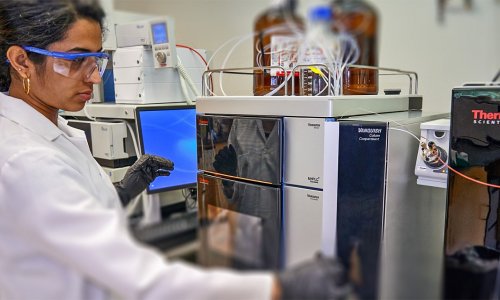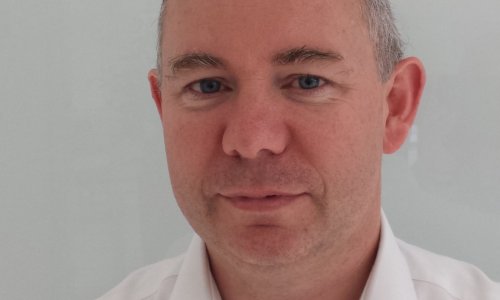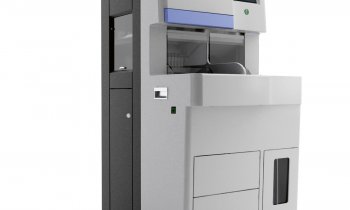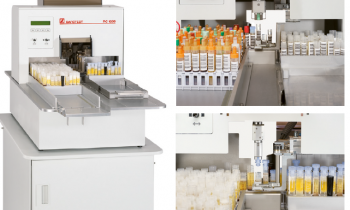Article • Automation
Mass spectrometry is advancing laboratory practice
Mass spectrometry is moving laboratory medicine to increasingly automated discrete analysis methods, resulting in ever faster and more reliable results.
Report: Mark Nicholls
It is also leveraging economies of scale as an increasingly cost-effective tool, says Craig Webster, Consultant Clinical Scientist and Clinical Lead, Department of Biochemistry and Immunology at Heartlands Hospital in Birmingham. Speaking about ‘Advances in Mass Spectrometry – future diagnostic uses’ during FiLM 2018 – Frontiers in Laboratory Medicine congress this January, Webster outlined how mass spectrometry is being automated for common analytes and how this may change laboratory medicine practice.
Advances in mass spectrometry and lab automation began growth in the mid-1990s and although some issues still include lack of sensitivity, cost, the highly specialist nature of the technique, ion suppression, sample variation, and some concern over standardisation of assays, he confirmed that mass spectrometry had emerged as the gold standard method for analytes. However, he added: ‘Because you have a fixed cost in the equipment you get better investment leverage from the technology if you put a massive workload through; you then get the benefits from the investment.’
From 20 samples a week to 65,000 per year – and more
However, there are difficulties in method optimisation and troubleshooting and the extra clinical information can often lead to over-investigation of patients.
Craig Webster
Webster, a consultant clinical biochemist for more than a decade, outlined the evolving use of mass spectrometry in Heartlands through the example and testing for Vitamin D deficiency, which started in his area 2006, and how that has moved forward in the last decade or so. With the initial technology his team examined 20 samples weekly, rising to 3,200 samples a year and then 4,500 in 2008, upgrading the Sciex API mass spectrometry system with a Tecan automated workflow solution and cutting the chromatography time from 10 minutes to two-and-a-half minutes. ‘Further workflow steps were automated with pipetting and removing of hexane, and online extraction meant we could take more costs out of the system,’ he said. ‘We had high quality extraction, achieved really clean samples, had good equipment, better uptime and less cleaning.’
By 2010 they handled 35,000 samples a year and 65,000 by 2013, introducing barcode recognition and an interface into the Laboratory Information Management System (LIMS) as the workload increase. Webster said his lab is at a stage where a medical laboratory technician could operate the system with minimal running costs, few sample rejections, and very few repeats. Cost per sample is now £3.10 with 95% done within 14 days. The team is moving towards multiplexing assays with mass spectrometry and simultaneously measuring multiple analytes in one run, but he also warned of disadvantages.

‘The advantages are that the sample only has to be prepared once; there’s faster turnaround time, combined calibration and controls and it offers extra clinical information,’ Webster said. ‘However, there are difficulties in method optimisation and troubleshooting and the extra clinical information can often lead to over-investigation of patients.’ One more general issue is that the technological advances have exposed a lack of skills from informatics training. ‘It’s not just about putting a computer on the system; it’s about how that fits in with workflow and the people who work within that,’ Webster continued, adding: ‘More informatics training is important because without the IT we do not get full automation.’ With more trackable systems and electronic transfer of results, Webster said the system is now moving increasingly towards discrete analysers and an automated chemical analyser with the instrument performing tests on samples kept in discrete cuvettes in contrast to a continuous flow analyser. Mass spectrometry, he concluded, is now fully integrated into the LIMS and workflow at Heartlands, and needs less skilled staff, with an expansion into more analytes.
Profile:
Dr Craig Webster, Consultant Clinical Scientist at Birmingham Heartlands Hospital, is the clinical lead for Biochemistry and Blood Sciences, responsible for R&D in the department of Biochemistry and Immunology. He has developed a number of projects utilising LC/MSMS. His technical background is wide-ranging, with major interests in HPLC, mass spectrometry, capillary electrophoresis and information technology.
05.03.2018











